Is your SD card not showing up on your computer? In this MiniTool guide, I will walk you through feasible solutions, including checking physical connections, updating disk drivers, changing the drive letter, and even repartitioning or formatting the SD card if necessary.
“When I plugged my SD card into my laptop to back up, I was shocked. I can’t see it on “This PC”. The only way I can see it is if I go to Disk Management. How can I access/bring back its files without formatting? Help!!!”reddit.com
Does this situation sound familiar? You are definitely not the only one facing it.
“SD card not showing up” is a common problem across tech forums. Many users have no idea what happened or how to recover files and restore the card to a working condition.
Maybe you are stuck with questions like:
- Why is my SD card inserted but not showing in File Explorer?
- Can I fix the card without losing data?
Let’s start with the first step: understanding why your SD card is not being read in File Explorer or Disk Management.
Why Is My SD Card Not Showing Up on My Computer
Common Causes of SD Card Not Showing Up
Typically, your memory card may not appear due to one or more of the following reasons:
Physical Problems
- A damaged SD card, card reader, or USB port can prevent proper connection and detection of your card.
- Many SD cards have a small lock switch on the side to protect data from being modified. Sometimes, if the switch is in the Locked position, recognition issues can happen.
Driver Issues
SD cards rely on drivers to communicate with your operating system. If the disk driver is outdated, corrupted, or missing, it can prevent the computer from recognizing the SD card.
File System Errors
The file system of the SD card defines how data is stored. If it is corrupted, your system may not recognize the disk structure and cause recognition issues.
No Drive Letter Assigned
Without a valid drive letter, the memory card won’t show up in File Explorer and cannot be opened.
Partition Loss
The SD card’s partition may have been deleted or lost due to human error, virus attacks, etc. This makes the card invisible in Windows Explorer.
Unpartitioned SD Card
If the card has not been partitioned yet, Windows will detect it in Disk Management but not show a usable partition in File Explorer.
Now that you know the common reasons why your card may not appear, the next step is to check whether your computer is actually detecting it.
Check if Your SD Card Shows Up in Disk Management
- Right-click the Start button and choose Disk Management.
- In Disk Management, check whether your SD card is listed.
If it is not listed, refer to the solutions under Case 1. If it is listed, go to Case 2 for solutions.
Case 1. SD Card Does Not Appear in Disk Management
When your memory card is not displayed in Disk Management, you are likely dealing with a connection issue, driver problem, or even physical failures.
Let’s look at what to do to fix it.
Solution 1. Check Physical Connections
First, try the following basic troubleshooting steps to rule out connection issues:
- Remove and reinsert the card carefully into the card reader.
- Connect the card reader to another USB port.
- Clean the SD card’s metal contacts with a soft cloth.
- Change to a different card reader.
- Connect the card to another computer or device.
If nothing changes, proceed with the next method.
Solution 2. Unlock the SD Card
Some SD cards have a physical lock switch on the side.
In most cases, a locked card will still show up on your computer, but you won’t be able to modify your files on it.
However, some users reported that a locked switch can occasionally prevent the card from being detected at all.
So, try unlocking the SD card:
- Remove the SD card from the card reader.
- Find the small switch on the side of the card.
- If it is set to Lock, slide the switch to the Unlock position.
- Reinsert the card and check if it now shows up in File Explorer.
If the card still doesn’t appear, move on to the next solution.
Solution 3. Run Hardware and Devices Troubleshooter
Windows has a built-in troubleshooter that is called the Hardware and Devices troubleshooter. It is used to detect and fix common hardware issues, including problems with your SD card.
So, when your SD is not detected, try running this troubleshooter:
Step 1. Press Windows + R to open the Run dialog.
Step 2. Input msdt.exe -id DeviceDiagnostic in the text box and press Enter.
Step 3. The Hardware and Devices troubleshooter will show up. Click Next to detect and repair problems.

If the Hardware and Devices troubleshooter does not fix the card, try the next solution.
Solution 4. Update/Reinstall the Disk Driver
If your SD card is not detected due to a corrupted, missing, or incompatible driver, updating the driver can help fix the problem.
Here is how to update a disk driver in Device Manager:
Step 1. Right-click the Start button and choose Device Manager.
Step 2. Expand the Disk drives category.
Step 3. Right-click your memory card and choose Update driver.
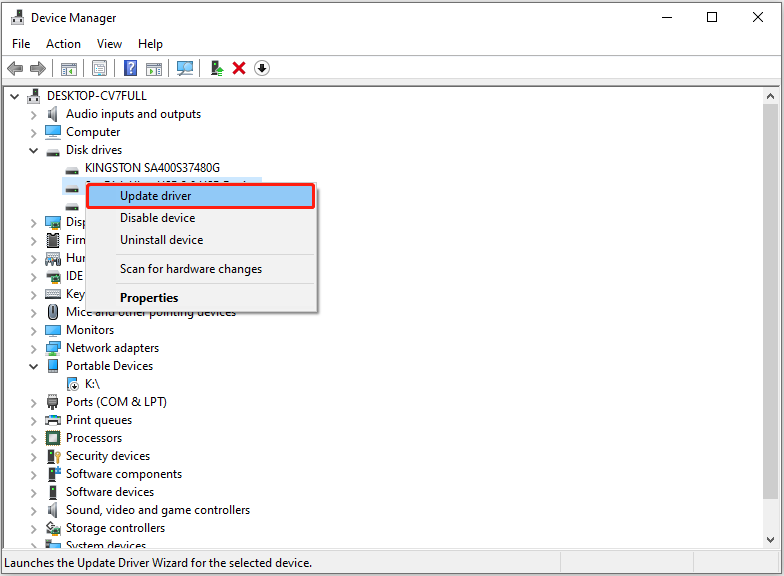
Step 4. Select the option to let Windows search automatically for the most appropriate driver and wait for the process to complete.
If updating the driver does not fix the problem, try uninstalling the device completely, and then reinstall the driver:
Step 1. In Device Manager, right-click your SD card and choose Uninstall device.
Step 2. Click Uninstall to confirm.
Step 3. Restart your computer and reinsert the SD card. Then Windows will automatically install the disk driver.
If the problem persists, try the next solution.
Solution 5. Turn on SD Card Support From BIOS/UEFI
When the SD card or card reader is deactivated in BIOS or UEFI, the card won’t be detected by your computer.
Here is how to enable the SD card reader support in BIOS or UEFI.
Step 1. Restart your computer. During boot, press F2, F12, Esc, or Del to enter BIOS/UEFI.
Step 2. Once in the BIOS/UEFI window, navigate through the menus to find the section related to devices.
Then, look for settings related to the SD card reader, which might be shown as SD Card, Card Reader, or similar.
Step 3. If the SD card reader is disabled, enable it. Then save the change and exit BIOS/UEFI.
Once the card reader support is enabled, your card should appear. If not, try the following method.
Solution 6. Scan for Viruses/Malware
Malware or viruses can prevent the SD card from working properly. So, try performing a virus scan to check your computer for malicious software and remove it.
Here is how to use Windows Defender to do a virus scan.
Step 1. Type Virus & threat protection in the Windows search box, and click it from the best match results to open it.
Step 2. Click Quick scan to directly start a quick scan. Or, click Scan options to select from Quick scan, Full scan, Custom scan, and Microsoft Defender Offline scan.
Step 3. After selecting the scan option, click Scan now.

Case 2. SD Card Appears in Disk Management
If your SD card does show up in Disk Management, it is not a connection or hardware issue.
Instead, it is most likely a file system error, unallocated space, unpartitioned disk, or a missing drive letter.
The fixes here are different from Case 1. Let’s walk through the solutions.
Solution 1. Add/Change a Drive Letter
If your SD card is missing a drive letter in Disk Management, it is time to add one.
Here is how to add a drive letter:
Step 1. Right-click the Start button and select Disk Management.
Step 2. Right-click your SD card partition that does not have a drive letter and choose Change Drive Letter and Paths.
Step 3. Click the Add button.
Even if your SD card already has a drive letter, it is a good idea to click Change and assign a new one.
Why? Drive letter conflicts or glitches can still prevent the card from being detected.
Step 4. Choose an available drive letter from the drop-down list and click OK.
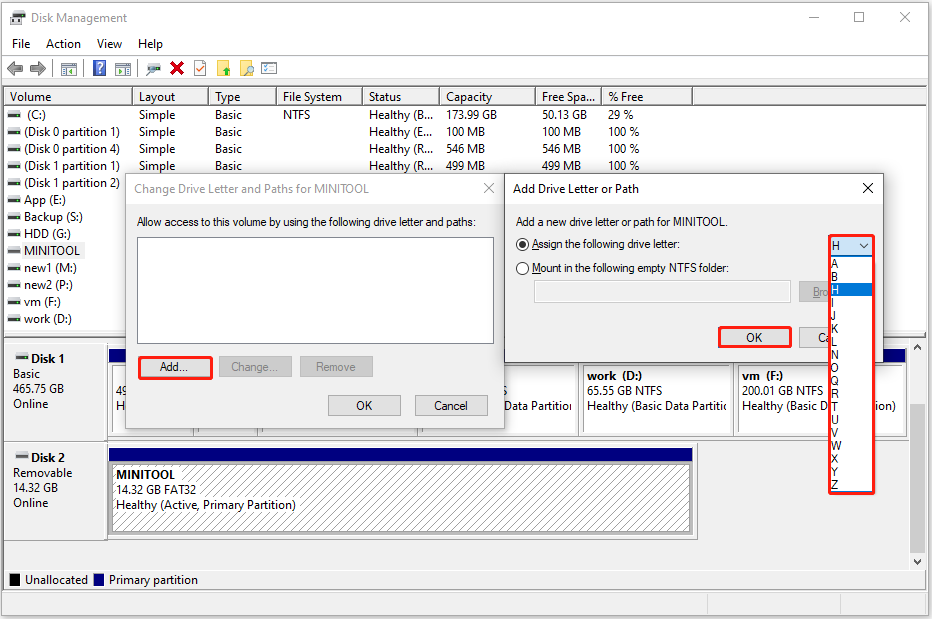
If the card is still missing, move to the next fix.
Solution 2. Check the SD Card for File System Errors
File system errors can make your SD card unreadable even if it is detected properly.
How to fix file system errors on your SD card? Open Command Prompt and run the CHKDSK command.
Step 1. In the Windows search box, type cmd. The Command Prompt result shows up. Right-click it and choose Run as administrator.
Step 2. When the User Account Control window appears, click Yes to open Command Prompt.
Step 3. Type chkdsk [drive letter]: /f /r /x and press Enter. Replace [drive letter] with the letter of the SD card you want to scan.
For example, to repair the H drive, type chkdsk H: /f /r /x.
- /f: This parameter instructs CHKDSK to fix errors found on the selected drive.
- /r: This parameter implies /f. It is used to locate bad sectors on the disk and recover readable information from them.
- /x: This parameter forces Windows to stop using the drive before checking it. It also fixes any errors on the drive, like the /f option does.
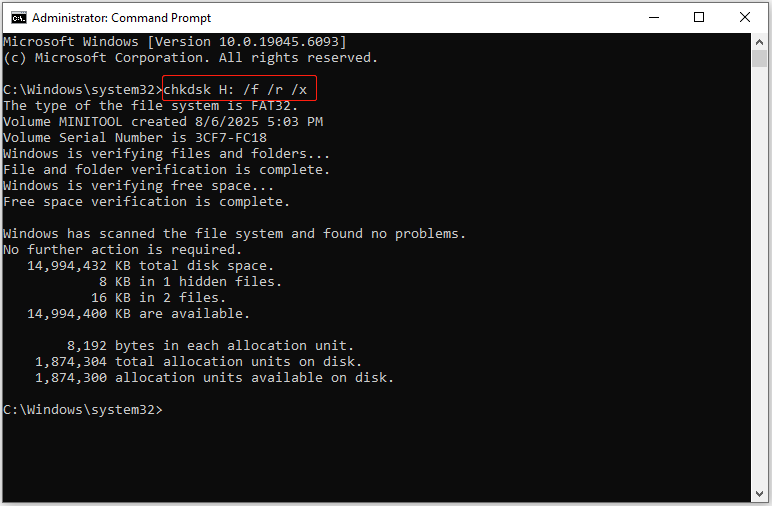
Once the CHKDSK command completes, it will show whether any errors were found and fixed on the SD card. This information helps you understand if the file system issues have been resolved or if further steps are needed.
Solution 3. Repartition the SD Card
If your SD card shows as unallocated, you will need to repartition it to make it usable again. But do not do that now because repartitioning the drive will delete everything on the card.
If there are important files on the SD card, recover them first.
Before Partitioning the Disk: Recover Files From Unallocated Space
How can you recover files from lost partitions? MiniTool Power Data Recovery can help.
MiniTool Power Data Recovery is a professional data recovery tool designed for Windows users.
It supports recovering files from unallocated space, lost partitions, or drives in other states.
Supported file types include documents, pictures, videos, audio files, emails, archives, databases, and more.
It is easy to use this free data recovery software to recover files:
- Select the SD card to scan.
- Find and preview found files.
- Save the required files to a safe location.
MiniTool Power Data Recovery FreeClick to Download100%Clean & Safe
Here is how to use this reliable file recovery tool to recover files from your SD card:
>> Step 1. Select the SD Card to Scan.
Launch this MiniTool data recovery program to enter the main interface. Under the Logical Drives section, you will see all partitions or unallocated spaces on your computer.
Find the lost partition of your SD card according to the USB icon, volume size, and other information. Then click the Scan button to start scanning for files.

>> Step 2. Locate and Preview Files.
Once the full scan is completed, it is time to browse through the found files and locate the files you want to recover.
Path and Type are two file view options.
- Path: Classifies files by original file structure. Use it when you remember where the files were originally stored.
- Type: Organizes files by file type and data format. Use it when you only remember the file type, like photos, documents, or videos.
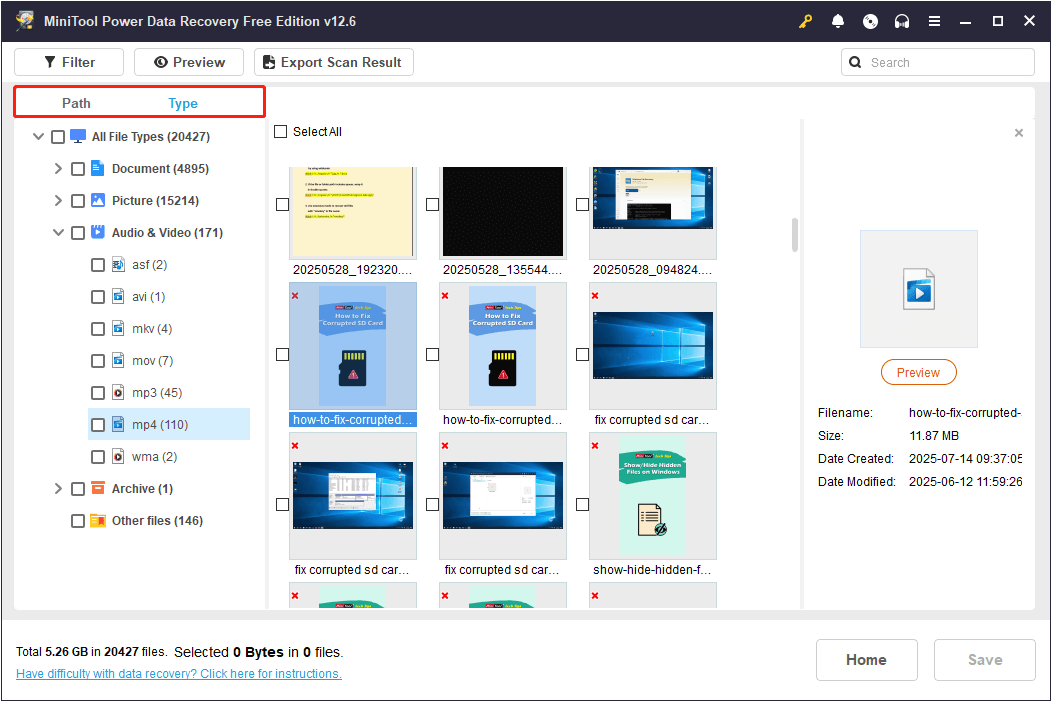
Want to narrow down the file list further? Filter and Search can help.
- Filter: Quickly filters only specific files by file type, file modification date, file size, and file category.
- Search: Already know the file name or part of it? Type it into the search box and press Enter to locate it immediately.
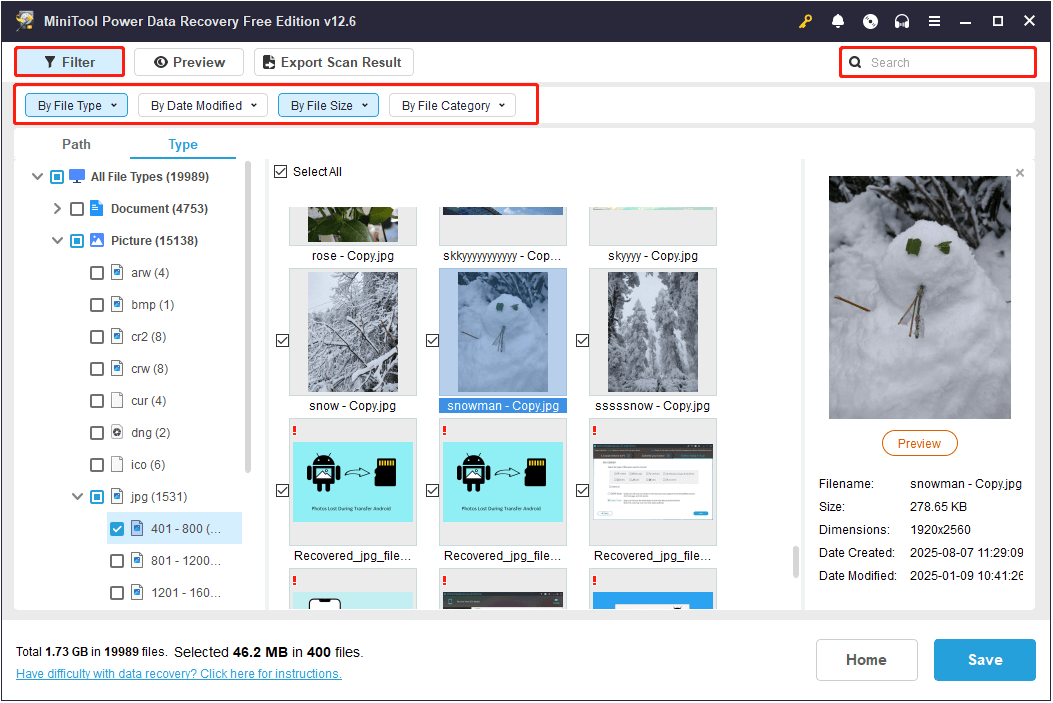
After locating a desired file, you can double-click it to check its content.
>> Step 3. Save Required Files.
Browse through the found files and make sure to check all the ones you want to recover. Then, click Save.
In the new window, choose a safe location to store the recovered files.
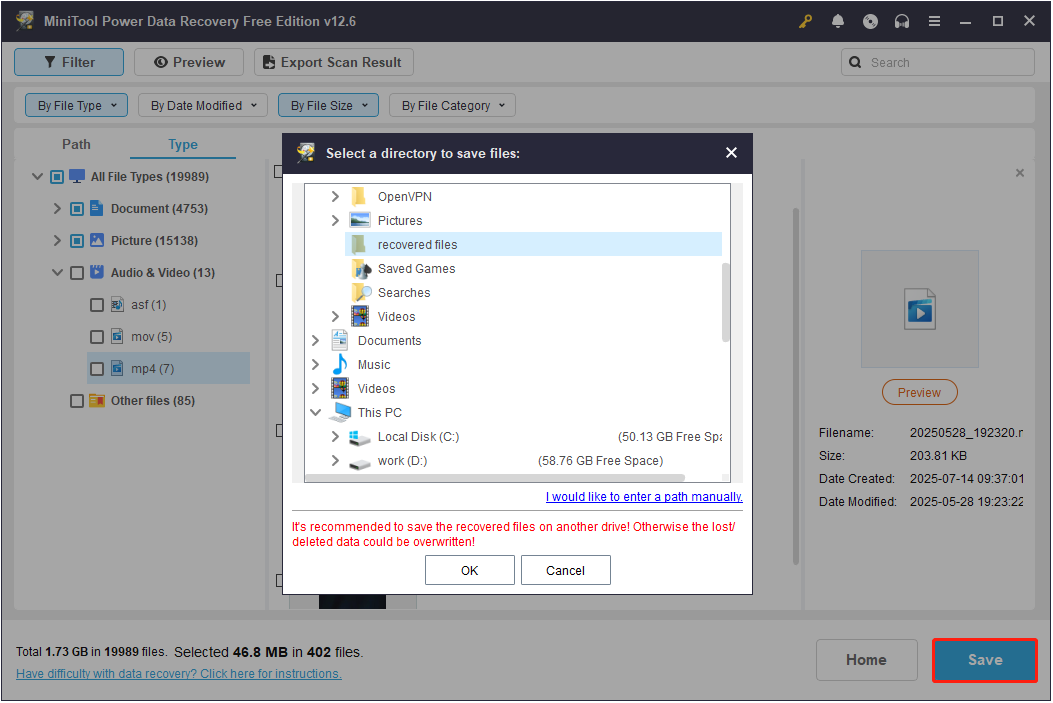
Steps to Partition the SD Card
After rescuing your files, you can now create a new partition on the SD card to make it usable.
Here is how to partition an SD card:
Step 1. In Disk Management, right-click the unallocated space and choose New Simple Volume.
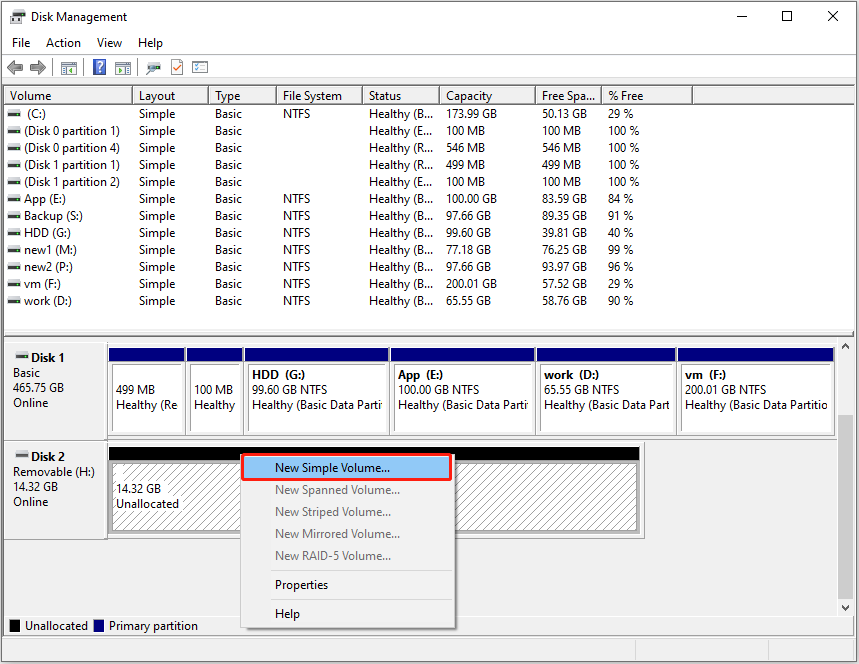
Step 2. Click Next to continue.
Step 3. Set up the volume size and click Next.
Step 4. Choose a drive letter and click Next.
Step 5. Choose a file system, type a volume label, and hit Next.
Step 6. Click Finish.
MiniTool Partition Wizard FreeClick to Download100%Clean & Safe
Still can’t see your card? Let’s try the next fix.
Solution 4. Initialize the SD Card
When an SD card shows as Unknown or Not Initialized in Disk Management, it won’t be displayed in Windows Explorer.
To make the card visible, initialize it, and then partition it.
Here are the steps.
Step 1. In Disk Management, right-click the card and choose Initialize Disk.
Step 2. Select a preferred partition table from MBR (Master Boot Record) and GPT (GUID Partition Table). Then click OK.
Step 3. Once initialized, right-click the unallocated space and choose New Simple Volume.
Step 4. Follow the wizard to partition the card.
Solution 5. Format the Memory Card
The last method to restore the normal functionality of your SD card is to format it.
You can complete this process from Disk Management.
Step 1. Right-click the problematic SD card partition and choose Format.
Step 2. Set up the volume label and file system. Tick Perform a quick format and click OK.
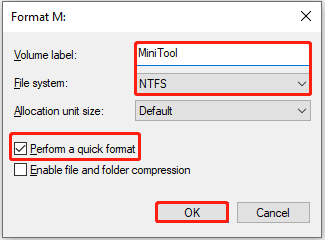
Step 3. Click OK to confirm.
Bottom Line
If your SD card is not showing up in Windows 10/11, do not worry. The solutions above should help you bring it back.
If you need further assistance while using MiniTool products, feel free to contact the support team at [email protected].
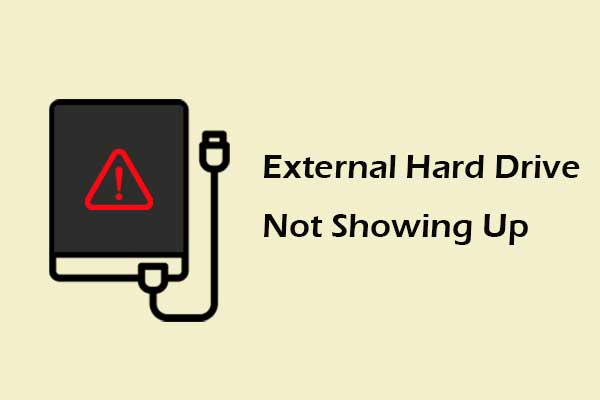
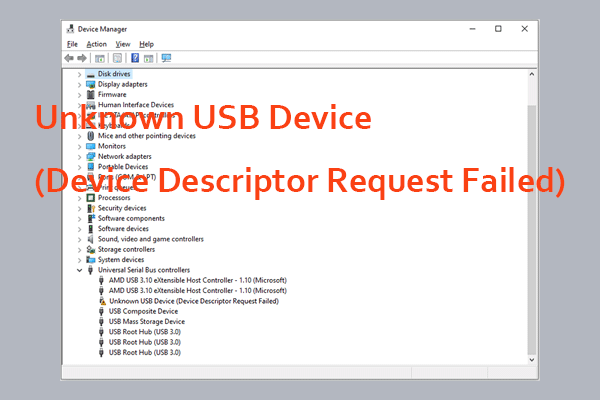
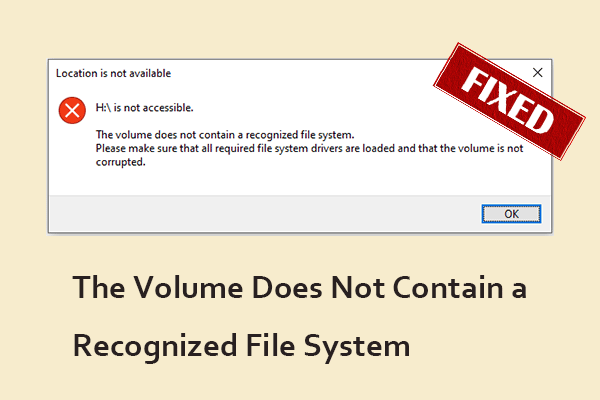
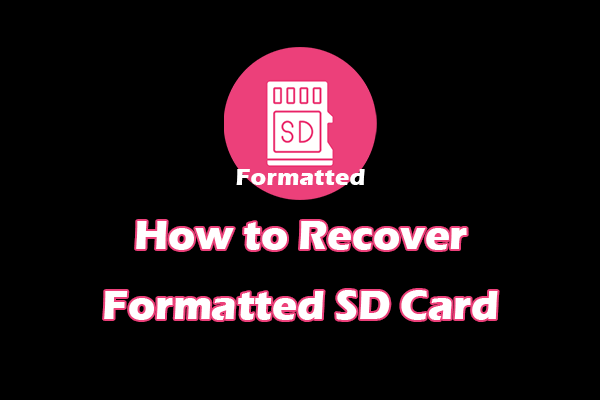
User Comments :